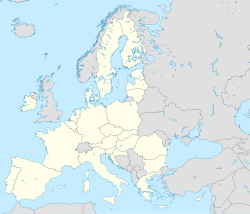 Logo | |
| Abbreviation | ERC |
|---|---|
| Formation | 2007 |
| Purpose | Fund excellent research conducted in Europe |
| Location | |
| Owner | European Union |
| Budget | €13 billion (2014–2020) |
| Website | erc |
The European Research Council (ERC) is a public body for funding of scientific and technological research conducted within the European Union (EU). Established by the European Commission in 2007, the ERC is composed of an independent Scientific Council, its governing body consisting of distinguished researchers, and an Executive Agency, in charge of the implementation. It forms part of the framework programme of the union dedicated to research and innovation, Horizon 2020, preceded by the Seventh Research Framework Programme (FP7). The ERC budget is over €13 billion from 2014 – 2020 and comes from the Horizon 2020 programme, a part of the European Union's budget. Under Horizon 2020 it is estimated that around 7,000 ERC grantees will be funded and 42,000 team members supported, including 11,000 doctoral students and almost 16,000 post-doctoral researchers. The ERC awards to individuals are widely considered to be either among the most, or else the most prestigious grant for academics in Europe. [1] [2] [3] [4] [5] [6]
Contents
- Background
- Organisation
- Scientific Council
- Executive Agency
- Measures to ensure an integrated institution
- Budget and peer review
- Grants offered
- Principles
- Schemes
- Annual applications
- Availability of publications and results
- See also
- Notes
- References
- External links
Researchers from any field can compete for the grants that support pioneering projects. The ERC competitions are open to top researchers also from outside the union. The average success rate is about 12%. [7] Five ERC grantees have won Nobel Prizes. [8] [9] [10] Grant applications are assessed by qualified experts. Excellence is the sole criterion for selection; there are neither thematic priorities, nor geographical quotas for funding. The aim is to recognise the best ideas, and confer status and visibility to the best research in Europe, while also attracting talent from abroad.
Along with national funding bodies, the ERC aims to improve the climate for European frontier research. The Scientific Council has been keen to learn from the ERC's peers in national research councils (European and overseas) and to engage in dialogue and appropriate collaboration.




